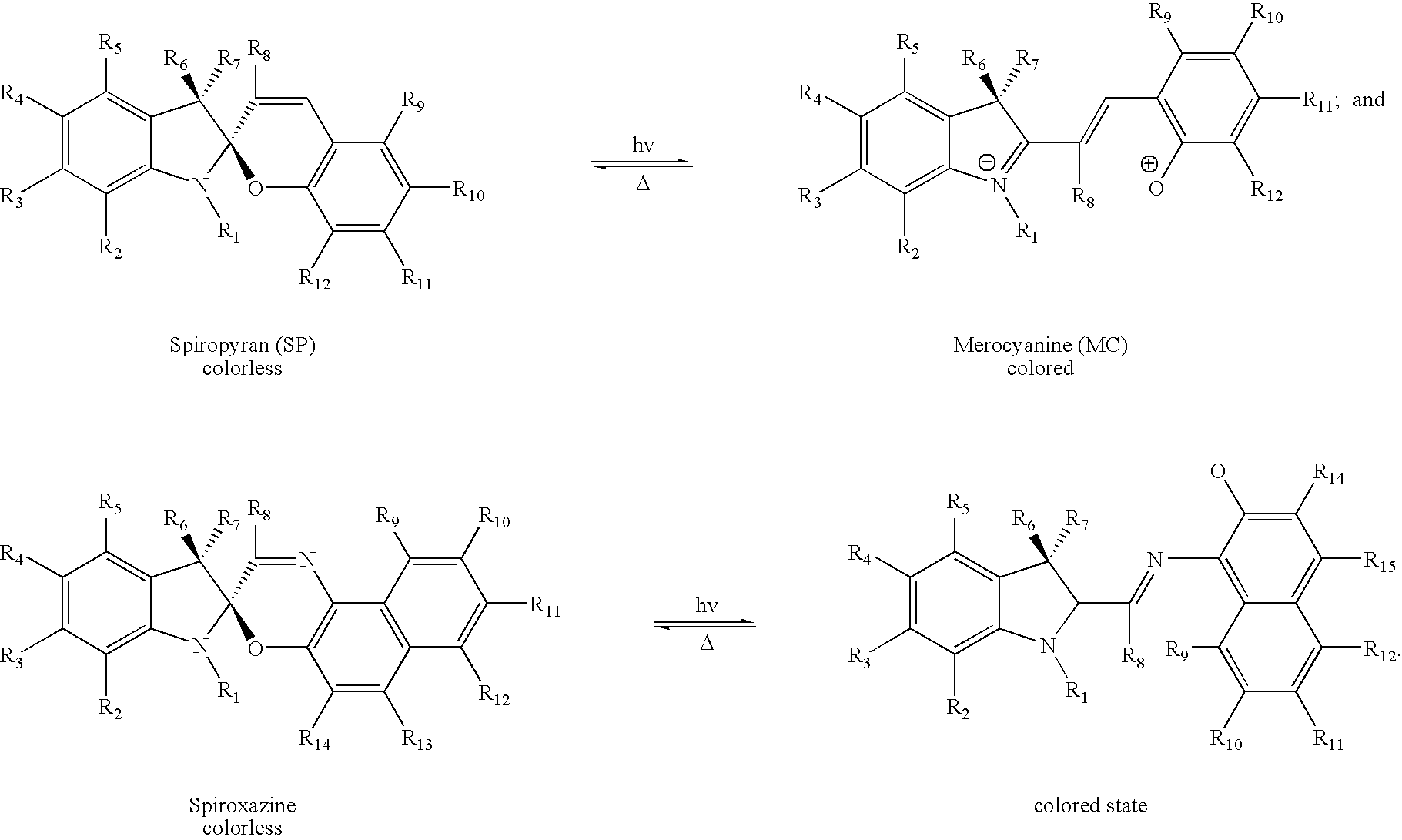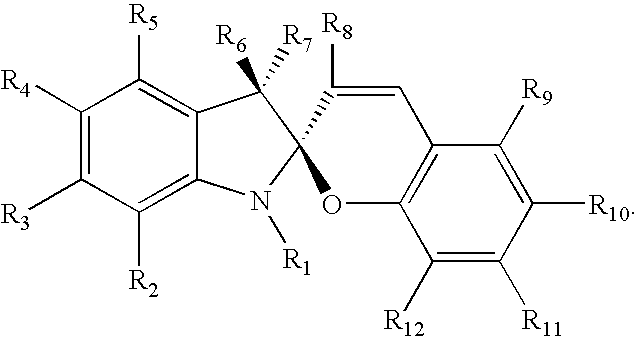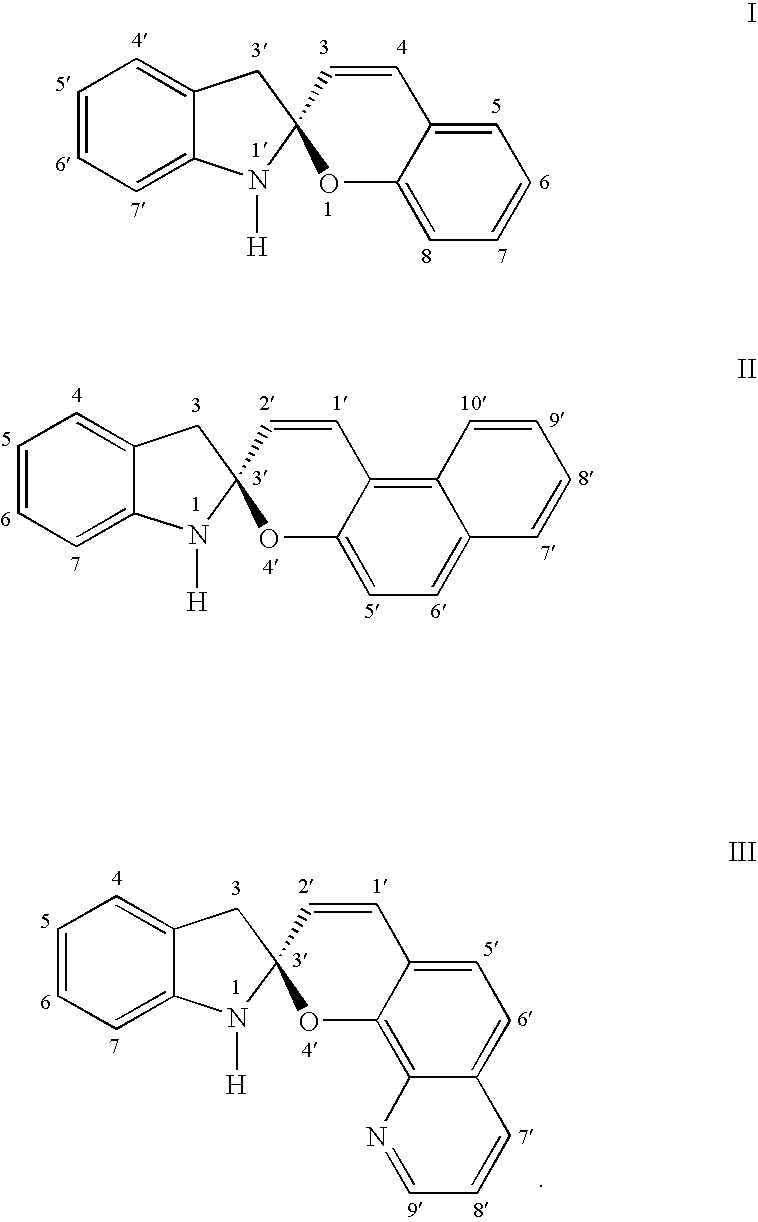Thermochromic recording medium
a recording medium and thermochromic technology, applied in thermography, photosensitive materials, instruments, etc., can solve the problems of significant environmental environmental and economic costs, huge quantity of discarded paper documents, and the disposal of these discarded paper documents
- Summary
- Abstract
- Description
- Claims
- Application Information
AI Technical Summary
Benefits of technology
Problems solved by technology
Method used
Image
Examples
example i
[0075]An active medium was spin coated on glass slides from a solution containing 50 mg of a spiropyran compound of the formula:
[0076]
one equivalent of zinc chloride (ZnCl2) and 0.625 grams of polymethyl methacrylate (PMMA) in 2.5 ml of tetrahydrofuran (THF) as a solvent.
[0077]The polymer film was heated at 100° C. in an oven for a few minutes. After heating, the sample became dark orange.
[0078]The film was allowed to self erase under ambient light conditions. Full erasure was achieved in a few hours. Faster erasure was obtained by illuminating the sample with visible light (greater than 450 nm) of high intensity from a xenon lamp with an appropriate cutoff filter.
example ii
[0079]A white paper medium was prepared by soaking the paper in a composition comprising 50 mg of the spiropyran compound used in Example I, three equivalents of zinc chloride, and 0.625 grams of PMMA in 2.5 ml of THF as a solvent.
[0080]Paper sheets containing the thermochromic composition were tested by heating at a temperature of 120° C. on a hot plate. The heated portion of the paper turned an orange color, while the unheated portion remained in a white colorless state. One paper sample was kept in the dark for about a week and no decay of the colored state was observed.
[0081]The thermochromic materials from Examples I and II can be switched to the colored state (orange in this case) by the use of high intensity UV light. The efficiency of coloration with UV light, however, is much lower as compared to the coloration obtained by heating. This indicates that the document and the thermochromic composition have a relatively reduced sensitivity to the UV component of ambient room lig...
example iii
[0082]Active media was spin coated on glass slides from a thermochromic composition comprising 50 mg of a spiroxazine compound of the formula:
[0083]
three equivalents in zinc chloride, and 0.625 grams of PMMA in 2.5 ml of THF as a solvent.
[0084]The polymer film was heated at 100° C. in an oven for a few minutes, and the sample became dark blue. Full erasure of the dark blue colored state was achieved after a few hours under ambient light conditions.
[0085]The optical density of the dark and light states was measured. The optical density of the dark thermochromic colored state was 2.07, and the optical density for the white (colorless) state was 0.25. The results provide a contrast ratio of 66. A contrast ratio of higher than 10 is considered very good in any e-paper documents. High contrast ratios are important for high resolution devices.
PUM
| Property | Measurement | Unit |
|---|---|---|
| temperature | aaaaa | aaaaa |
| thickness | aaaaa | aaaaa |
| visible time | aaaaa | aaaaa |
Abstract
Description
Claims
Application Information
 Login to View More
Login to View More - R&D
- Intellectual Property
- Life Sciences
- Materials
- Tech Scout
- Unparalleled Data Quality
- Higher Quality Content
- 60% Fewer Hallucinations
Browse by: Latest US Patents, China's latest patents, Technical Efficacy Thesaurus, Application Domain, Technology Topic, Popular Technical Reports.
© 2025 PatSnap. All rights reserved.Legal|Privacy policy|Modern Slavery Act Transparency Statement|Sitemap|About US| Contact US: help@patsnap.com



